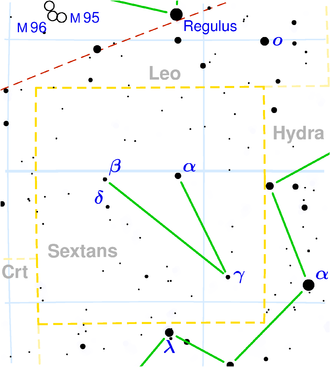NGC 3337
| Galaxy NGC 3337 |
|
|---|---|

|
|
| SDSS | |
| AladinLite | |
| Constellation | sextant |
|
Position equinox : J2000.0 , epoch : J2000.0 |
|
| Right ascension | 10 h 41 m 47.6 s |
| declination | + 04 ° 59 ′ 18 ″ |
| Appearance | |
| Morphological type | S0 ^ - |
| Brightness (visual) | 14.0 mag |
| Brightness (B-band) | 14.8 mag |
| Angular expansion | 0.6 ′ × 0.3 ′ |
| Position angle | 45 ° |
| Surface brightness | 12.0 mag / arcmin² |
| Physical data | |
| Redshift | 0.026982 ± 0.000173 |
| Radial velocity | 8089 ± 52 km / s |
|
Stroke distance v rad / H 0 |
(356 ± 25) x 10 6 ly (109.1 ± 7.7) Mpc |
| history | |
| discovery | Albert Marth |
| Discovery date | March 22, 1865 |
| Catalog names | |
| NGC 3337 • PGC 31860 • CGCG 037-119 • 2MASX J10414755 + 0459181 • GC 5528 • GALEX ASC J104147.65 + 045918.7 | |
NGC 3337 is a spiral galaxy of Hubble type S in the constellation Sextant south of the celestial equator . It is estimated to be 356 million light years away from the Milky Way and has a diameter of around 60,000 ly.
In the same area of the sky are the galaxies NGC 3326 , NGC 3341 , IC 636 .
The object was discovered by Albert Marth on March 22, 1865 .
